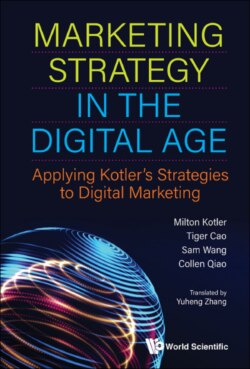Читать книгу Marketing Strategy In The Digital Age: Applying Kotler's Strategies To Digital Marketing - Milton Kotler - Страница 15
На сайте Литреса книга снята с продажи.
1.1.1 Digitalization of information exchange 1.1.1.1 Searching
ОглавлениеSearching is the most basic information tool in the Internet. By taking new search engine technologies, digital information can be accessed with ease. Using a search engine to explore can help enterprises and consumers locate target information within seconds, largely improving business efficiency. Keyword searches are one of the most elementary applications of online searching. With the better performing computing power, storage capacity and network speed currently available to us, we have access to advanced methods in searching. For example, users can search information by voice or visual search. Customized searching results can be offered by combining personal searching history and positioning information, etc.
From the perspective of enterprises, for many years, people from digital marketing have been continuously optimizing search engines. In fact, search engine optimization (SEO) has always been one of the important tools to increase online views for enterprises. However, with higher processing speed and upgraded machine-learning technologies as well as searching technologies, search engine service providers (Google, Baidu, etc.) have gradually enhanced the ratio of advanced searching technologies like semantic search. For users, they have access to more accurate information in line with their own needs. However, effects of traditional means like optimizing the webpage and buying keywords may be waning.
Semantic search technologies originated from May 2012. Launched by Google, “Knowledge Graph” service is a semantic search engine with some artificial intelligence technologies. Compared with traditional searching technology, Knowledge Graph’s search target is real “things” rather than a “character string”, and it can gather valuable information from the searching behaviors of users. Knowing the connection between over 570 million entities and over 18 billion facts, it continues to improve the searching experience. It is noticeable that semantic technologies are not only limited to external search engines like Google or Bing but also applied in social media. Image search is a search engine system of Facebook similar to Google’s “Knowledge Graph”, which further blurs the boundary between searching and social activities. If search engines can identify and understand a personal problem, it can offer personalized results. In conclusion, a search engine is starting to think and act like human beings.
The development of cloud computing, semantic searching technologies and data collection enable the learning capacities of computers to grow by leaps and bounds. Computers understand users’ intentions better, deeper and faster. In some cases, computers can even estimate the searching requirements of users without further user information.
Mobile technologies, voice recognition and big data can help computers retrieve a mass of the Internet, social media and geo-location data. Based on the filtration and categorization of the data, computers can more accurately predict the future requirements and behaviors of users.
